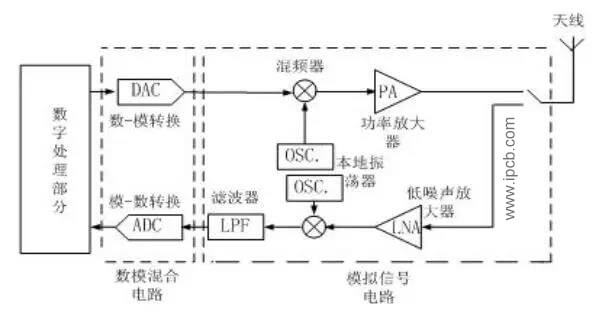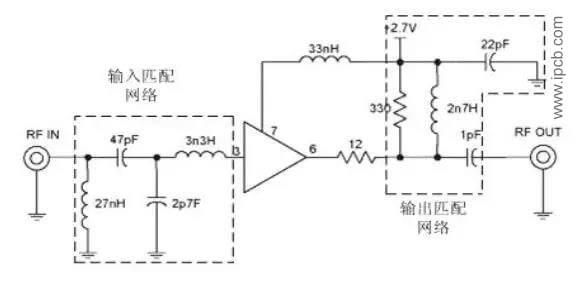1.What is a radio frequency circuit or what is RF?
Radio frequency is abbreviated as RF. Radio frequency is radio frequency current, which is the abbreviation of a high-frequency alternating electromagnetic wave. Alternating current that changes less than 1,000 times per second is called low-frequency current, and alternating current that changes more than 1,000 times is called high-frequency current, and radio frequency is this high-frequency current.
Radio frequency circuits are circuits that process electromagnetic wavelengths of signals on the same order of magnitude as the size of the circuit or device. At this time, due to the relationship between device size and wire size, the circuit needs to be processed using distributed parameter theory. This kind of circuit can be regarded as a radio frequency circuit, and there are no strict requirements on its frequency. For example, AC transmission lines (50 or 60Hz) that transmit over long distances sometimes need to be treated with RF theory.
2.Radio frequency circuit principle (RF principle) and development
The most important application area of radio frequency circuits is wireless communications. Figure A is a block diagram of a typical wireless communications system. Let's take this system as an example to analyze the role of radio frequency circuits in the entire wireless communication system.

Figure A: Typical RF system block diagram
This is a system model of a wireless communication transceiver, which includes a transmitting circuit, a receiving circuit and a communication antenna. This transceiver can be used for personal communications and wireless LAN. In this system, the digital processing part mainly processes digital signals, including sampling, compression, encoding, etc., and then converts the analog form into an analog signal circuit unit through an A/D converter.
The analog signal circuit is divided into two parts: the transmitting part and the receiving part.
The main function of the transmitting part is to upconvert the low-frequency analog signal output by DA conversion and the high-frequency carrier provided by the local oscillator into a radio frequency modulated signal through the mixer, and the radio frequency signal is radiated to the space passing through the antenna.The main function of the receiving part is: the space radiation signal is coupled to the receiving circuit through the antenna, the received weak signal is amplified by the low-noise amplifier, and the local oscillator signal is down-converted into a signal component containing an intermediate frequency signal and passed through the mixer. The function of the filter is to filter out the useful if signal, then input it into the A/D converter to convert it into a digital signal, and then enter the digital processing part for processing.
Next, the components and characteristics of a general RF circuit are discussed with respect to the low-noise amplifier (LNA) shown in the block diagram of Figure a.
Figure B is a circuit board diagram of the amplifier, taking TriQuint's tga4506-sm as an example. Note that the input signal is fed to the amplifier module through a matched filter network.Generally,the amplifier module uses a transistor common-emitter structure, and its input impedance must match the output impedance of the filter in front of the low-noise amplifier to ensure optimal transmission power and minimum reflection coefficient.This matching is required for RF circuit design. In addition, the output impedance of the LNA must match the input impedance of the back-end mixer, so as to ensure that the output signal of the amplifier can be input into the mixer completely without reflection.These matching networks consist of microstrip lines and sometimes separate passive components. However, their electrical properties at high frequencies are quite different from those at low frequencies. It can also be seen from the figure that the microstrip line is actually a copper-clad strip with a certain length and width. The microstrip line is connected to thin-layer resistors, capacitors and inductors.

Figure B tga4506-sm PCB layout
In electronics theory, when current flows through a conductor, a magnetic field is formed around the conductor; when alternating current passes through a conductor, an alternating electromagnetic field is formed around the conductor, called electromagnetic waves.
When the electromagnetic wave frequency is lower than 100kHz, the electromagnetic wave will be absorbed by the surface and cannot form effective transmission. However, when the frequency of electromagnetic waves is higher than 100kHz, electromagnetic waves can propagate in the air and be reflected by the ionosphere at the outer edge of the atmosphere, forming long-distance transmission capabilities. We call high-frequency electromagnetic waves with long-distance transmission capabilities radio frequencies. High frequency circuits basically consist of passive components, active components and passive networks. The frequency characteristics of components used in high-frequency circuits are different from those in low-frequency circuits. Passive linear components in high-frequency circuits are mainly resistors (capacitors).
In the field of electronic technology, the characteristics of radio frequency circuits are different from ordinary low-frequency circuits.The main reason is that the circuit characteristics under high frequency conditions are different from those under low frequency conditions, so we need to use the theory of radio frequency circuits to understand the working principle of radio frequency circuits.At high frequencies,stray capacitance and stray inductance have a great impact on the circuit. Stray inductance exists in conductor connections and in the internal self-inductance of the component itself. Stray capacitance exists between conductors in a circuit and between components and ground. In low-frequency circuits, these spurious parameters have little impact on the performance of the circuit. As the frequency increases, the influence of spurious parameters becomes more and more serious.In early VHF band television receivers, the effect of stray capacitance was so great that additional capacitance was no longer necessary.
In addition, there is a skin effect in RF circuits.Different from direct current, current flows through the entire conductor at direct current and flows through the surface of the conductor at high frequency.Therefore,high-frequency AC resistance is greater than DC resistance.
Another problem in high-frequency circuits is the effect of electromagnetic radiation. As frequency increases, the circuit becomes a radiator when the wavelength is equivalent to circuit size 12.At this time,various coupling effects will occur between circuits and between circuits and the external environment, leading to many interference problems. These issues are usually insignificant at low frequencies.
With the development of communication technology, the frequency of use of communication equipment is increasing day by day. Radio frequency (RF) and microwave (MW) circuits are widely used in communication systems. The design of high-frequency circuits has always received special attention from the industry. New semiconductor devices enable the expansion of high-speed digital systems and high-frequency analog systems.
The carrier frequencies of the microwave radio frequency identification system (RFID) are 915MHz and 2450MHz; the carrier frequencies of the Global Positioning System (GPS) are 1227.60mhz and 1575.42MHz; the radio frequency circuits in personal communication systems work at 1.9GHz and can be integrated into smaller sizes In personal communication terminals; 4GHz uplink is included in the C-band satellite broadcast communication system communication link and 6GHz downlink communication link. Typically, these RF circuits operate at frequencies above 1GHz, and this trend will continue as communications technology develops. However, it not only requires special equipment and devices, but also requires theoretical knowledge and practical experience that are not found in DC and low-frequency circuits.